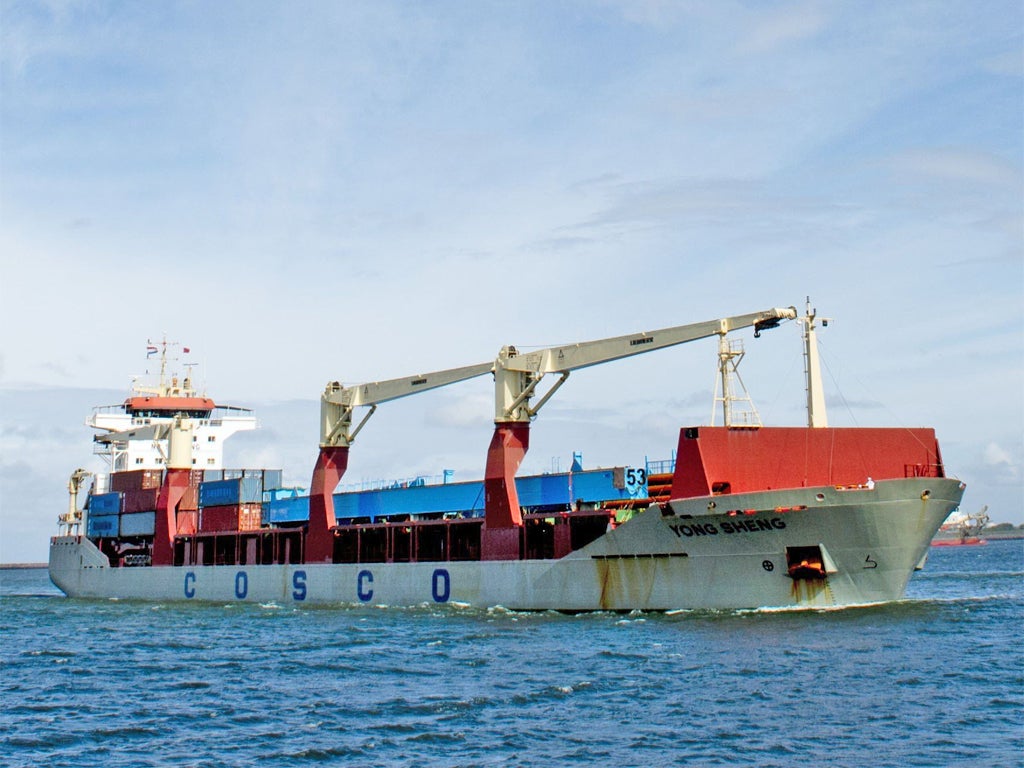The shipping forecast - it’ll be colder but much, much quicker: New Arctic shipping route saves up to two weeks’ travel between Asia and Europe
Via the Northern Sea Route, ships can make the journey in 35 days, instead of the usual 48

Its cargo was unremarkable: dismantled cranes to be used to hoist containers on to ships. But when the Yong Sheng sailed into Rotterdam this week, the boat and its crew were greeted with bouquets of roses, Chinese television crews, and the cheers of company officials who say they have made history.
While sailing from Dalian, in China, to the Dutch port of Rotterdam is one of the most plied routes in the world, the Yong Sheng has become the first commercial Chinese container vessel to make the journey through the icy waters of the Arctic, rather than south via the Indian Ocean and the Suez Canal.
As global warming leads to a decline in Arctic ice, shipping-company officials are rubbing their hands at the prospect of a “Golden Waterway” which could cut journey times and reduce the cost of transporting goods from Asia to Europe. “It saves between 12 and 14 days of transit,” said Ron Sallet, a manager in Rotterdam for the state-owned Cosco Group, which operates the Yong Sheng.
Although there was much fanfare on Tuesday afternoon when the ship finally docked, she was not the first vessel to use that route: Russian authorities said that 46 permits were granted last year for ships to sail through its Arctic waters. What makes the Yong Sheng unique is that she was the first Chinese merchant vessel to make the journey, demonstrating its commercial potential for the world’s biggest exporter.
Via the Northern Sea Route (NSR), ships can make the 8,100-nautical-mile journey in about 35 days, instead of 48 through the southern route, saving fuel and therefore money. But there is at least one snag: right now, ships can make the journey for only about 10 weeks a year, during a window between July and November, when summer temperatures thaw the ice.
And the Arctic Institute, an independent think-tank, said in an analysis on its website that ships still run the risk of getting stuck in ice, which would then incur delays and the cost of calling out a Russian ice-breaking vessel to free them. Although ship owners see the potential of the route, many believe it will be years before it will be commercially viable.
“Large-scale transarctic shipping and a shift in global trade patterns towards the Arctic… are far from becoming a reality,” wrote Andreas Raspotnik, an analyst at the institute. “Traffic along the NSR will continue to be dominated by regional – primarily Russian – traffic and remain a seasonal and niche trade route.”
But decades ago, such journeys were not possible at all. Now, as scientists blame climate change for heating up the oceans, the level of ice in the Arctic has reduced by about 25 per cent over the past 30 years. Results of a study by the European Space Agency’s CryoSat mission released today found that the volume of sea ice in the Arctic hit a new low this year, and some scientists predict that the Arctic could experience ice-free summers by 2030.
This is worrying environmentalists, who are calling for more research into the Arctic’s delicate ecosystems before 20,000-tonne vessels carrying heavy fuel oil start chugging through the pristine waters every summer.
“If we are concerned about the potential for oil spills in this region and we know that we do not have sufficient resources to clean up a potential oil spill, then the best way to avoid that would be to only let ships with clean fuel sail through this region,” said Nina Jensen, the head of WWF Norway.d
Join our commenting forum
Join thought-provoking conversations, follow other Independent readers and see their replies
Comments
Bookmark popover
Removed from bookmarks